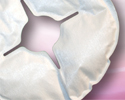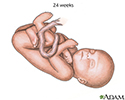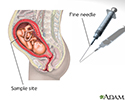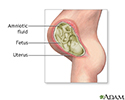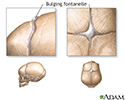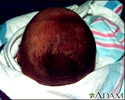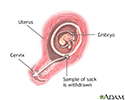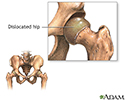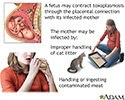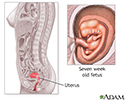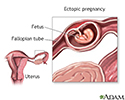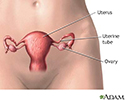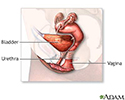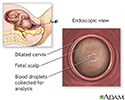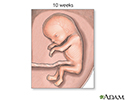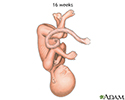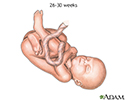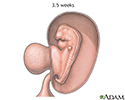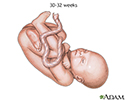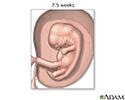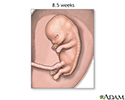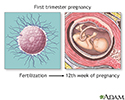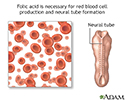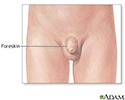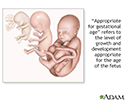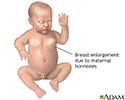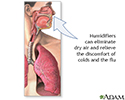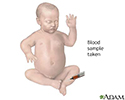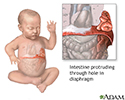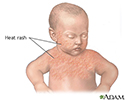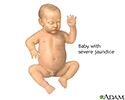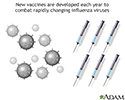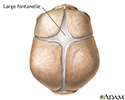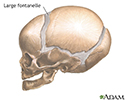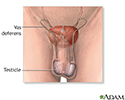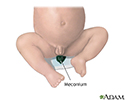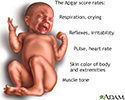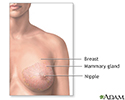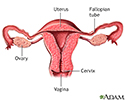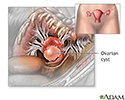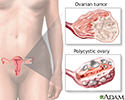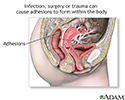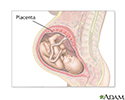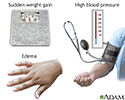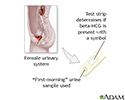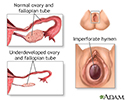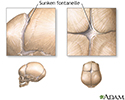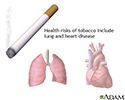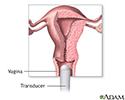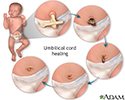Multimedia Gallery
Egg cell production
For conception to take place, a mature egg cell, or ovum, must be at the right place at the right time. Conception takes place when a sperm penetrates the egg cell and fertilizes it, and the two cells combine to form a new life. Let's take a quick look at some of a woman’s key reproductive organs and see how they function during menstruation and ovulation, two processes that are critical in preparing her for conception.
Here are the uterus, ovaries, fallopian tubes, and vagina.
You can see a cut-away view of one of the ovaries on the right. The purple structures inside the ovary are immature egg cells, or oocytes. All of the 400,000 egg cells a woman will ever produce are already present in her ovaries when she is born, although the eggs are in an undeveloped form. The average age that girls begin to menstruate is 12 years old. Each menstrual cycle occurs approximately every twenty-eight days. During each cycle, hormonal messages from the brain cause the ovaries to develop a single mature egg cell for potential fertilization, even as other hormones instruct the uterine lining to thicken in preparation for nourishing the fertilized egg cell. As you may know, hormones are chemicals released into the blood stream by organs or glands. In general, their job is to regulate body functions by either stimulating or inhibiting other cells or organs. The ovaries are just one of the many organs in the body regulated by hormones. The cycle starts when a follicle grows within one of the ovaries. A follicle is composed of the developing egg cell and the support cells that surround and nourish it.
On day 1 of the cycle, a small structure in the brain, the pituitary gland, releases two hormones: FSH and LH, both of which cause the follicle to begin growing. Over the next 13 days, the growing follicle releases estrogen, a hormone that prepares the lining of the uterus to receive a fertilized egg cell. Meanwhile, the estrogen in the blood stream causes the brain to release a surge of LH. In response to the LH surge, the follicle enlarges rapidly. On day 14, it ruptures and releases the egg cell in a process known as ovulation. The ruptured follicle begins secreting the hormone progesterone, which also helps to prepare the uterine lining for a fertilized egg cell.
The large structure on the right is the entrance to the fallopian tube. The smaller, waving structures at its opening are called fimbriae. They're moving a lot because it's their job to sweep the egg cell into the fallopian tube's entrance and toward the uterus. Once the egg cell is within the fallopian tube, one of two things will happen to it: it will either be fertilized by a sperm cell, or fertilization will fail to take place.
If the egg cell is NOT fertilized within 12 to 24 hours after its release from the ovary, it will stop developing and will dissolve before reaching the uterus. The absence of a fertilized egg cell gradually causes a woman’s body to stop releasing the hormones that would otherwise prepare the uterus for the developing egg cell. In response, the uterus sheds its lining on days 24 through 28 during menstruation. If the egg cell DOES become fertilized by a sperm, it will be transported by tiny hair-like cells, called cilia, to the uterus. There, it lodges in the uterine wall in a process called implantation, and receives nourishment from the uterine lining. Meanwhile, back in the ovary, the remaining cells of the ruptured follicle produce progesterone so that the uterine lining will stay rich in blood vessels, and the fertilized egg cell will survive.
As you can see, the hormones, which control the reproductive system, maintain a delicate balance over the life cycle of the egg cell.
Egg cell production
Review Date: 5/14/2024
Reviewed By: John D. Jacobson, MD, Professor Emeritus, Department of Obstetrics and Gynecology, Loma Linda University School of Medicine, Loma Linda, CA. Also reviewed by David C. Dugdale, MD, Medical Director, Brenda Conaway, Editorial Director, and the A.D.A.M. Editorial team.
Animations
- Breast engorgement
- Cell division
- Cesarean section
- Conception - general
- Conception - pregnancy
- Conception of identical twins
- C-section
- Early labor
- Egg cell production
- Egg production
- Endometriosis
- Fetal ear development
- Formation of twins
- Human face formation
- Infant formulas
- Kids - How big is the baby?
- Kids - How does the baby co...
- Kids - Is it a girl or boy?
- Kids - Umbilical cord
- Kids - Where do babies come...
- Newborn jaundice
- NICU consultants and suppor...
- Ovulation
- Placenta delivery
- Placenta formation
- Preeclampsia
- Pregnancy
- Pregnancy care
- Sperm production
- Sperm release pathway
- Storing breast milk
- The role of amniotic fluid
- Twin-to-twin transfusion sy...
- Ultrasound
- Vaginal delivery
Illustrations
- 24-week fetus
- Abnormal discharge from the...
- Abnormal menstrual periods
- Absence of menstruation (am...
- Amniocentesis
- Amniocentesis
- Amniotic fluid
- Amniotic fluid
- Anatomy of a normal placenta
- Antibodies
- Baby burping position
- Bananas and nausea
- Blood cells
- Blood test
- Breast infection
- Breastfeeding
- Bulging fontanelles
- Candida - fluorescent stain
- Caput succedaneum
- Cesarean section
- Cesarean section
- Cesarean section
- Childbirth
- Chorionic villus sampling
- Congenital hip dislocation
- Congenital toxoplasmosis
- Crying - excessive (0 to 6 ...
- Delivery presentations
- Developmental milestones
- Early weeks of pregnancy
- Ectopic pregnancy
- Emergency Childbirth
- Emergency Childbirth
- Endocrine glands
- Endometriosis
- Endometritis
- Erythroblastosis fetalis - ...
- Female breast
- Female reproductive anatomy
- Female reproductive anatomy
- Female reproductive anatomy...
- Female urinary tract
- Fetal blood testing
- Fetal head molding
- Fetus at 10 weeks
- Fetus at 12 weeks
- Fetus at 16 weeks
- Fetus at 26 to 30 weeks
- Fetus at 3.5 weeks
- Fetus at 30 to 32 weeks
- Fetus at 7.5 weeks
- Fetus at 8.5 weeks
- First trimester of pregnancy
- Folic acid
- Folic acid benefits
- Folic acid source
- Follicle development
- Fontanelles
- Foreskin
- Gestational ages
- Gestational diabetes
- Gonadotropins
- Head circumference
- Heat rash
- Height/weight chart
- Hormonal effects in newborns
- Humidifiers and health
- Hysterectomy
- Infant blood sample
- Infant care following delivery
- Infant diaphragmatic hernia
- Infant heat rash
- Infant intestines
- Infant jaundice
- Infantile reflexes
- Influenza vaccines
- Intraductal papilloma
- Intrauterine transfusion
- Jaundiced infant
- Large fontanelles
- Large fontanelles (lateral view)
- Macrosomia
- Male reproductive anatomy
- Male reproductive anatomy
- Male urinary tract
- Mammary gland
- Meconium
- Morning sickness
- Moro reflex
- Newborn head molding
- Newborn test
- Normal female breast anatomy
- Normal uterine anatomy (cut...
- Ovarian cyst
- Ovarian hypofunction
- Overproductive ovaries
- Pelvic adhesions
- Pelvic laparoscopy
- Placenta
- Placenta
- Placenta
- Placenta previa
- Polyhydramnios
- Preeclampsia
- Pregnancy test
- Primary amenorrhea
- Primary infertility
- Secondary amenorrhea
- Secondary infection
- Side sectional view of fema...
- Single palmar crease
- Skull of a newborn
- Slit-lamp exam
- Sperm
- Stein-Leventhal syndrome
- Sunken fontanelles (superio...
- Tobacco health risks
- Transvaginal ultrasound
- Ultrasound in pregnancy
- Ultrasound, color - normal ...
- Ultrasound, normal fetus - ...
- Ultrasound, normal fetus - ...
- Ultrasound, normal fetus - ...
- Ultrasound, normal fetus - face
- Ultrasound, normal fetus - ...
- Ultrasound, normal fetus - foot
- Ultrasound, normal fetus - ...
- Ultrasound, normal fetus - ...
- Ultrasound, normal fetus - ...
- Ultrasound, normal fetus - ...
- Ultrasound, normal placenta...
- Ultrasound, normal relaxed ...
- Umbilical cord healing
- Uterus
- Vaginal bleeding during pre...
- Well baby visits
- Yeast infections

 Bookmark
Bookmark



























